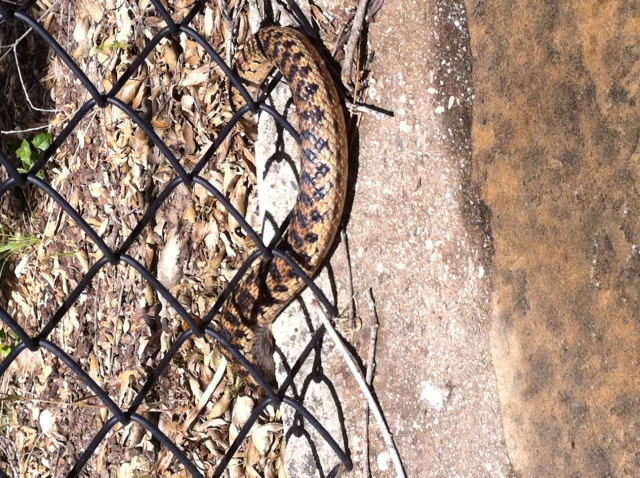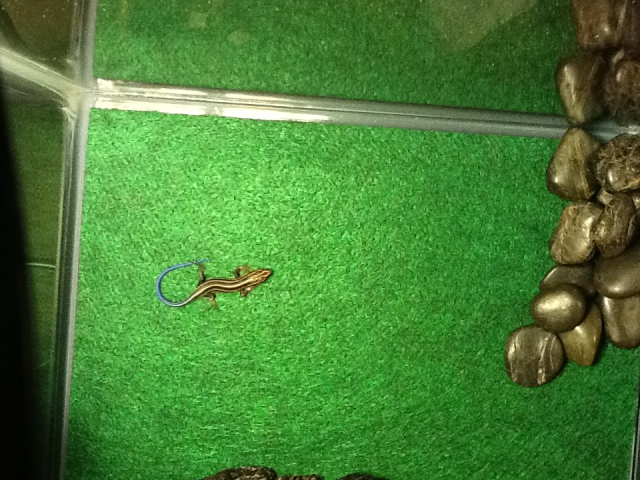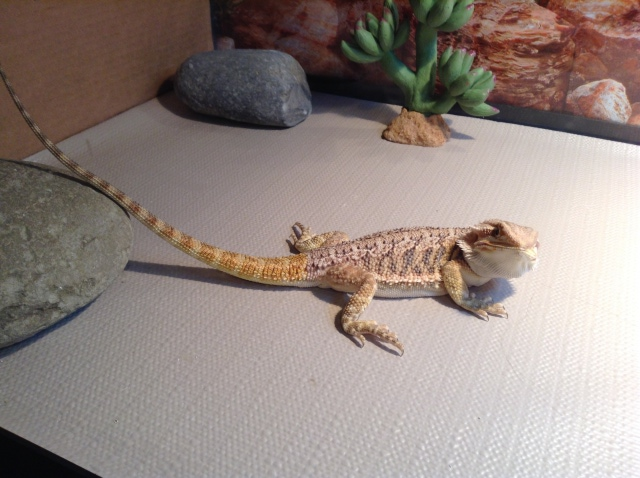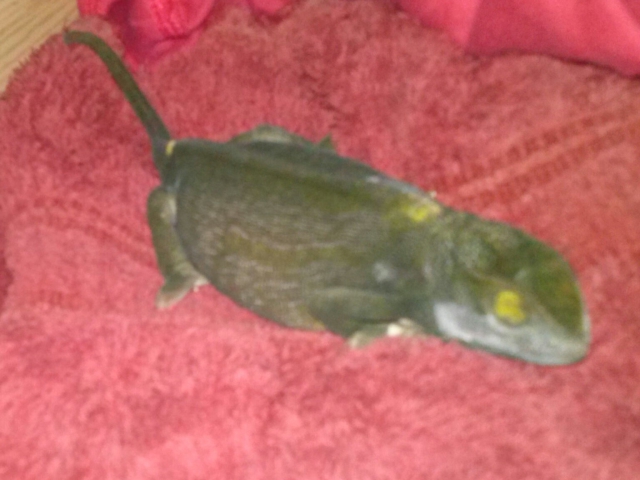QuestionHey Sorry to bother you but I couldn't find an answer threw research my 12 week old leopard gecko Terra has started chasing its own tail round and around it's verry funny but don't know what he will do when he/she catches it and don't want my little friend to hurt its self dose this meen she/he wants more bugs? it gets around 6 approximately sized locust or mealworms a day the temps on its heat mat are 90 and its eating and pooing fine it just got me curious thank you for your help and opinion in advance :-)
AnswerHi Shane,
No one really knows why reptiles do odd things, like chase their tails. You would think they recognize it as a part of their body but they act like they think it is an insect because it is moving. If he does catch it, he may bite and let go, in which case you will have to apply some antibiotic ointment such as Neosporin and of course, watch for infection. Worst case would be him dropping his tail because of grabbing onto it. In that case, you do have to make sure that he is eating very well as that they store their needed fat in their tails.
As to how much to feed.... general rule is to allow them to eat as many insects as they want in a 15 minute span. With the worms, you can get one of the dishes they can't escape from and leave a few in with him at all times if you feel it is needed. 6 mealworms really isn't much food so be sure you are allowing him to eat as much as he wants of them. Mealworms are very easy to raise and you then can really gut load the mealworms well so that your leo is getting good nutrition from them. Also, I've found that when raising your own, and feeding the meal worms leafy greens and fruits they don't develop as much as the hard outer body shell which make them safer for your leo to eat on a more regular basis if needed.
When insects are purchased from the pet store, they aren't properly gut loaded so be sure to feed the insects (not the gel stuff from the stores) for 24-48 hrs prior to feeding your gecko. Mealworms won't eat if in the fridge.
I'm including a basic care sheet I wrote to help people out with care. Your floor temperature is fine but be sure that the heat mat is only on about 1/3 of his habitat so that he also has the needed cooler temperatures.
BASIC CARE FOR A LEOPARD GECKO
Leopards are pretty easy to care for but they do need
special care. Here are some of the basic needs of your gecko.
HOUSING: The need to have at least a 20 gallon long tank for one Leo. This needs to have a secure fitting screen top...they can be quite the escape artists!!! They need to have a humid hide box.You can make this with something as simple as a small plastic dish with a hole cut in one side and a small mesh bag filled with some Sphagnum moss coconut bark or Peat moss that you mist.
I made mine out of the small plastic Folgers coffee containers...I cut an opening in the lid..and put the moss in..they LOVE it. I use the terrarium moss in mine.
I use that on the warm side of the tank. Be sure to provide a cool hide box on the other end. I also provide a mid temperature hide...which is in the middle of the tank.I use the critter caves which you can purchase. NOT the ones that have heat in them!!!!
Provide secure climbing areas for your gecko. Fake plants, rocks and branches are all fine to use. be sure there are no wires or sharp ends to any fake plants you use.
*****SUBSTRATE:(that's the stuff on the floor of your tank) Newspaper, lizard carpet or paper towels work great and are easy to clean and are much safer than any loose substrate. Sand or other loose substrate is not recommended as that they can be deadly to the leo when it is ingested(eaten, even by accident while eating their insects)...A very graphic site of an impacted leo surg can be seen at http://homepage.mac.com/exoticdvm/reptile/PhotoAlbum181.html it is very graphic!!! ******What I have found that works great for safety and heat distribution is using about 1/4 inch of children's play sand(since the tiles fit tight together, there is no sand danger) on the bottom of the tank and on top that you place ceramic or slate floor tile. What is nice is that the 12 x 12 squares fit perfect in a 20 gallon tank with no spaces between the tiles. The sand and the tile distribute the heat wonderfully. Using the under tank heater as described is what distributes the heat. Also, overhead heat will help in heating the tiles...I've been using this set up for several years and the leos love it. Using a tile that isn't smooth is recommended. **********
TEMPERATURES: They need a warm area ( on the floor) of 88-92 degrees and a
cooler area in the upper 70s, low 80s. At night their temperature can drop to the low to mid 70's.
Never use a hot rock for a leopard gecko...or any reptile.
They can severely burn any reptile. You can use a heating
pad under the tank,under tank heater for the warm area. You can use a regular household light bulb in a dome fixture with a ceramic socket in it to keep the warm area at the 88-92 degree area if needed there, otherwise, placing the light bulb about midway in the tank will give the needed temperatures throughout the tank. You may have to play with the wattage of the bulb but generally 40-60 watts is sufficient.At night, no white light. If room temperatures stay above 70 degrees, no extra night heat is needed. The under tank heater or heating pad should cover about 1/3 of the tank....be sure to raise the tank up about 1/4-1/2 inch off the stand when using an under tank heat source to prevent heat build up which can cause the glass to break and hot spots in the glass. Be sure to have a good layer of newspaper, carpeting or, even a thin flat rock(such as tile) on top the area that the under tank heat source is placed...if you use a thin rock or tile, it helps to distribute the heat very well.
You can use the special nighttime lights that are designed for reptiles. I like using a ceramic heat emitter on a thermostat for nighttime heat.
DO NOT use black lights or party lights as they can cause eye damage!!!!
The wattage you use will vary based on room temperature and size of tank.
LIGHTING: Leopard geckos do not need UVB lighting but it does not hurt them to give them uvb. They should have some type of light during the day, be it a uvb tube, regular florescent light, reptile day light or regular household light bulb. NO white lights at night!!!
FEEDING: Geckos should not be fed crickets or other insects that are bigger than the space between their eyes. Generally, hatchlings can be fed more than once a day,juvys can be fed twice a day, adults are fed once daily or every other day, in the early evening. Crickets and other food items such as silk worms, super, and an occasional treat of a wax worm, need to be dusted with a calcium supplement two times a week and also they should have a small dish of calcium in their tank. I use the lid of a milk jug for the little dish of calcium in their tank. For dusting the insects, Use a calcium with no added phosphorus. Insects must be gut loaded(fed) for at least 48 hours prior to feeding your gecko. Remove any uneaten crix or superworms after 15-20 minutes..... Place a piece of cut potato in the tank so that if you have missed any uneaten insects, they will eat the potato instead of nibbling on your gecko!!!
*************You have to be sure to feed your crickets and insects the right foods before feeding them to your gecko. If your crickets/insects are not healthy and well fed, your gecko will not get the nutrition he needs. You can gut load your crickets and insects greens, veggies, cereals or specially designed commercial foods for crickets or the insects you are feeding. ************
Be sure to have a small dish of clean water for your gecko at all times!!
You can offer them some baby food or fruits on occasion ...
Mine will even eat a small piece of watermelon now and then.WATER: always provide a dish of drinking water. If you choose to mist your gecko to drink, its best to not get the tank too wet as that they do not do well with higher humidity. Sometimes its better to take your leo out of their tank to mist them to get them to drink!!!
HANDLING: Some geckos enjoy being held...others prefer not to be handled at all. Be sure to be very gentle when holding your leo and NEVER grab them by the tail! Their tails are extremely fragile and will break.
I do suggest finding a vet that can treat reptiles BEFORE you actually need one!!! To find a vet that is able to care for reptiles:
http://www.herpvetconnection.com
http://www.arav.org/ECOMARAV/timssnet/amm/tnt_mdsearch.cfm
http://www.anapsid.org/vets/
For more information on leopard geckos:
http://www.drgecko.com
If you have any questions or don't understand something, please let me know.

 snake in the garden
QuestionSnake
QUESTION: Hi Chris
I have a snake
snake in the garden
QuestionSnake
QUESTION: Hi Chris
I have a snake
 Five lined skink
QuestionQUESTION: Hi, I live in myrtle beach sc a
Five lined skink
QuestionQUESTION: Hi, I live in myrtle beach sc a
 Bearded dragons
Question
Zoey
I have two questions! And I know e
Bearded dragons
Question
Zoey
I have two questions! And I know e
 Flap neck Chameleon. Urgent help PLEASE!
QuestionPaula about 8 hrs afte
Paula straight af
Flap neck Chameleon. Urgent help PLEASE!
QuestionPaula about 8 hrs afte
Paula straight af
 Lizard Indentification
Question
Unknow
Hi Diane,
Thanks for getting back so qu
Lizard Indentification
Question
Unknow
Hi Diane,
Thanks for getting back so qu